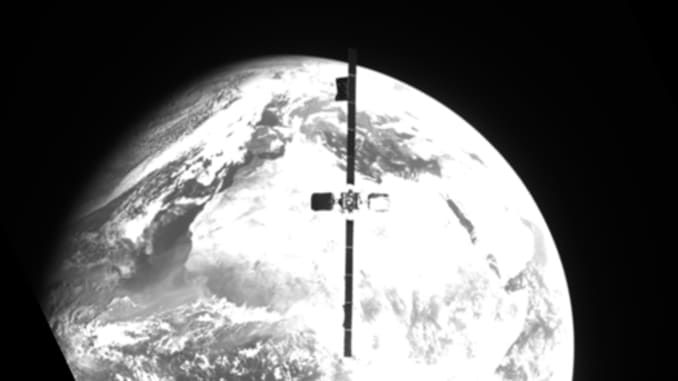
Last week, the American aerospace company Northrop Grumman and its subsidiary SpaceLogistics announced a successful test of a newly developed robotic satellite-servicing spacecraft, called Mission Extension Vehicle 2 (MEV-2). The robot craft successfully docked with a commercial communications satellite, Intelsat 10-02, on April 12, 2021. The MEV is designed to attach itself to aging satellites and to help prolong their operations in space. Newly released images (above and below) are from the perspective of the MEV’s wide-field infrared camera on approach to the satellite shortly before docking. Joe Anderson, the director of mission extension services at Northrop Grumman, said in a webinar following the docking:
This is the first time humans have seen this satellite since it launched in June of 2004.
In a statement, Northrop Grumman explained that – under the terms of Intelsat’s satellite life-extension servicing contract – the MEV-2 will provide five years of service to Intelsat 10-02 before undocking and moving on to provide services for a new mission.

MEV-2 launched in August 2020 on an Ariane 5 rocket and follows in the footsteps of its predecessor MEV-1, which had connected to a different Intelsat satellite in February 2020.
At that time, with MEV-1, the team behind the spacecraft had the servicing spacecraft dock with Intelsat 901 in what Anderson described as “the geo-graveyard orbit.” That’s about 186 miles (300 km) above geosynchronous orbit, which is 22,236 miles (35,786 km) above Earth’s equator. After docking, MEV-1 and its captured satellite moved into a higher orbit. They did this “out of a self-imposed abundance of caution,” Anderson said, as this mission was the first of its kind for the company. Following the success of MEV-1’s mission, Northrop and SpaceLogistics (a subsidiary of Northrop Grumman) were able to dock MEV-2 directly in geosynchronous orbit. Tom Wilson, vice president of strategic space systems at Northrop and president of SpaceLogistics, said:
With the docking of MEV-1 last February, we made history; we created an entirely new market in orbit. We are now the only provider of life extension services for satellites, operating not just one but two mission extension vehicles … with these capabilities, we can enable entirely new classes of missions.
Northrop Grumman’s MEVs are the company’s first line of robotic satellite-servicing spacecraft, but more are planned. At the end of the current five-year contract related to Intelsat 10-02, the MEV will be available to move to another satellite and dock. Both MEV-1 and MEV-2 are capable of working with multiple satellites in their lifetimes: repairing, changing, assembling, and inspecting them in orbit.
In 2024, Northrop Grumman intends to take its satellite life-extension capabilities a step further, by launching Mission Extension Pods, which the company is currently developing. Unlike the MEVs, these Pods are expected to be installed on both commercial and government satellites using Northrop’s Mission Robotic Vehicle (MRV).
These upgrades and new technologies come from a robotic servicing mission award granted last year to Grumman by the Defense Advanced Research Projects Agency (DARPA). Going forward, Northrop Grumman projects that, starting in 2025, they will begin refueling satellites in orbit and removing nearby debris from considerably high-value satellites. They’ll remove this debris, or space junk, from orbit also using the MRV’s robotic arms. Anderson told Space.com during the webinar:
Right now, we’re focusing on exploring how we can use the capabilities that the mission robotic vehicle will provide with its robotic arm capabilities, perhaps some new tools that we might incorporate onto the end of that robotic arm to be able to rendezvous with and then capture a body that needs removal from GEO [geosynchronous] orbit.
And then starting in 2030, the company has shared plans to begin assembling and manufacturing technology in orbit, too. They hope that this will allow them to overcome, Anderson said:
… the burdens on spacecraft design that rocket launches impose, resulting in new and exciting possibilities in space.
If you design a satellite that was manufactured in orbit … we estimate that maybe 80% of the mass of a satellite being launched is there to support the launch loads, so that’s a significant component to how spacecraft are designed today… So if we can design satellites that are manufactured, assembled in orbit, can completely change the economics of those assets.
Following the success of these life-extending space robots, Wilson added, the ultimate stage of assembling and manufacturing in space will be
… where the real change comes.
Bottom line: The American aerospace company Northrop Grumman and its subsidiary SpaceLogistics are testing a new line of satellite-serving spacecraft, designed to prolong satellites’ lives. So far, two Mission Extension Vehicles (MEV-1 and MEV-2) have docked successfully with satellites, most recently on April 12, 2021.











